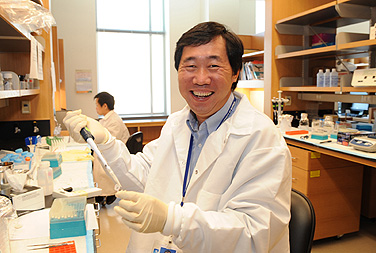Close Up
A new focus on stem-cell vision

Xiuqian Mu is studying the genes involved in the development of the retina and how they might be able to repair retinal damage. Photo: NANCY J. PARISI
-
 Print
Print -
 Comments
Comments
-
“I felt the environment was right for me—the people, the facilities, this brand new center and the other institutes around here.”
Over the past decade, UB’s stem cell research has brought together a score of investigators to explore, understand and translate the promise of stem cells into effective clinical therapies and treatments for diseases from Parkinson’s to muscular dystrophy, cardiovascular to diabetes.
Add glaucoma, one of the leading causes of blindness, to the mix in the work of UB’s newest arrival in stem-cell research, Xiuqian Mu (pronounced SHOO-che-an MOO), assistant professor in the Department of Ophthalmology and the Ira G. Ross Eye Institute. Mu arrived at UB’s New York State Center of Excellence in Bioinformatics and Life Sciences last July.
The soft-spoken scientist had been working on retinal development for nine years at the M.D. Anderson Cancer Center in Houston. The position at UB represents his first independent job (tenure-track). From the offers he fielded, the opening at UB proved to be the most attractive. “I felt the environment was right for me—the people, the facilities, this brand new center and the other institutes around here,” he says.
A member of the recently formed Developmental Genomics Group at the Center of Excellence, Mu’s overall research is in gene regulation, a fundamental process in all living organisms and all biological processes. He is studying the genes involved in the development of the retina and how they might be able to repair retinal damage. “The optical nerve is damaged in glaucoma,” he relates. “The axonal fibers in the optical nerve are sent out from one particular cell type—the retinal ganglion cells. These cells eventually die in glaucoma patients, which is why vision is lost. The hope is that if we understand how the cells are formed and maintained, we may be able to understand the causes of their deaths. We eventually may be able to make these cells for therapeutic purposes,” he says.
Mu’s research interest stems from his curiosity as a child growing up in a small village of Shandong province in eastern China along the Yellow Sea. Always fascinated by chemistry and how things react, he recalls taking apart various household gadgets like the radio to see what made it work, much to his father’s chagrin. His parents supported his endeavors, however, encouraging him to study to become a doctor, despite their humble means.
He went directly to medical school from high school, as is customary in China, but his heart was on the research side. After graduating from the medical school, Mu decided to pursue a Ph.D. in molecular biology at the prestigious Peking Union Medical College in Beijing.
Because the research environment in the early 1990s was not as conducive in China as it was in the U.S., he decided to make the leap, obtaining a fellowship with the National Institutes of Health. It was here that he decided to focus his studies on the eye and one of its most prevalent diseases.
Mu seems to have found a home at the Center of Excellence and values its interdisciplinary mission. “My research involves a lot of genomics as well as bioinformatics, and I need collaborators in those fields. It’s very, very easy to collaborate with these people here and that’s a big advantage,” he says. “And I’ve also made friends with people from different departments. The support of people here has been very helpful.”
Mu is eager to see UB’s Downtown Campus develop. He enjoys playing basketball on weekends with a group of Chinese postdocs and students in Alumni Arena’s Triple Gym. And he is developing an appreciation for the area.
“Buffalo has a great history and there is so much around, particularly the architecture. People are very, very friendly. I think with the environment and people, it’s all here for me to do what I want to do.”

Reader Comments